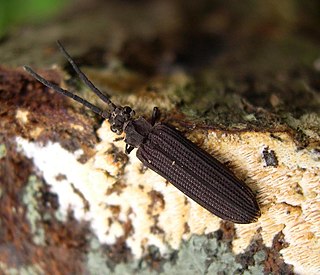
The Cupedidae are a small family of beetles, notable for the square pattern of "windows" on their elytra, which give the family their common name of reticulated beetles.
Adinolepis is a genus of beetles in the family Cupedidae containing four species, all endemic to Australia. A fifth species, Adinolepis scalena, was transferred to Ascioplaga in 2009.
Ascioplaga is a genus of beetles in the family Cupedidae, containing two species endemic to New Caledonia and one described from northern Queensland in Australia. The Australian species, Ascioplaga scalena, was originally described as a species of Adinolepis, and was transferred to Ascioplaga in 2009.
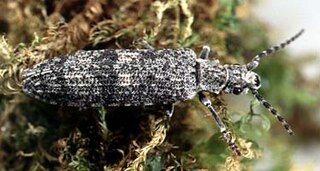
Priacma is a genus of beetles in the family Cupedidae. It contains a single extant species, Priacma serrata native to western North America and one fossil species, P. megapuncta from the Cenomanian aged Burmese amber. Species previously assigned to the genus from the Yixian Formation of China have been subsequently placed in the separate genus Apriacma.

Rhipsideigma is a genus of beetles in the family Cupedidae. It contains five species, four of which are endemic to Madagascar, the other being endemic to the northern coast of Tanzania. They vary in length from 13 mm to 20 mm, and are up to 6 mm wide.
Paracupes is a genus of beetles in the family Cupedidae, the reticulated beetles.

Lasioderma is a genus of beetles in the family Ptinidae. As of 1990, there were over 50 species in the genus.

Calymmaderus is a genus of beetles in the family Ptinidae. There are about 11 described species in Calymmaderus.
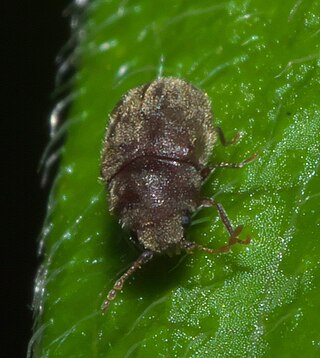
Protheca is a genus of beetles in the family Ptinidae. There are at least three described species in Protheca.
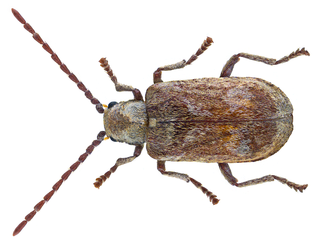
Hedobia is a genus of beetles in the family Ptinidae native to Europe and the Near East. There are at least four described species in Hedobia.

Trigonurus is a genus of rove beetles in the family Staphylinidae, the only family of the subfamily Trigonurinae. There are about nine described species in Trigonurus, found in the Holarctic.
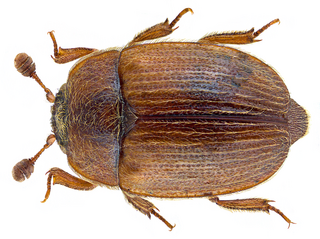
Pocadius is a genus of sap-feeding beetles in the family Nitidulidae. There are about nine described species in Pocadius.
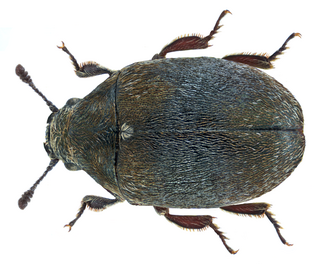
Morychus is a genus of pill beetles in the family Byrrhidae. There are at least three described species in Morychus.

Tenomerga cinerea is a species of reticulated beetle in the family Cupedidae. It is found in North America.
Podolasia is a genus of May beetles and junebugs in the family Scarabaeidae. There are about 11 described species in Podolasia.
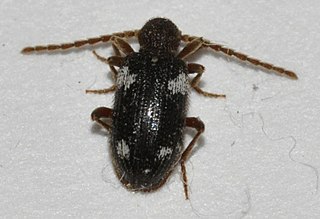
Ptinini is a tribe of spider beetles in the family Ptinidae. There are about 18 genera and at least 120 described species in Ptinini.
Phaenochilus is a genus of lady beetles in the family Coccinellidae. There are about 10 described species in Phaenochilus. It is found in Southeast Asia, India, and Japan.
2019 in paleoentomology is a list of new fossil insect taxa that were described during the year 2019, as well as other significant discoveries and events related to paleoentomology that were scheduled to occur during the year.
Burmese amber is fossil resin dating to the early Late Cretaceous Cenomanian age recovered from deposits in the Hukawng Valley of northern Myanmar. It is known for being one of the most diverse Cretaceous age amber paleobiotas, containing rich arthropod fossils, along with uncommon vertebrate fossils and even rare marine inclusions. A mostly complete list of all taxa described up until 2018 can be found in Ross 2018; its supplement Ross 2019b covers most of 2019.













